|
This chapter presents the latest U.S. farm household
income forecast for 2008 and revised estimates for 2007,
income estimates for earlier years, the composition of
farm household income, and comparisons of income for farm
households relative to other U.S. households. Information
on the distribution of farm household income in 2007 (the
latest year for which detailed data are publicly available)
is also reported.
Forecasts of Average Incomes of U.S. Farm Households,
2008
Estimates and forecasts of U.S. farm operator household
income are based on data from the Agricultural Resource
Management Survey (ARMS).
Income estimates for farm operator households presented
in this briefing room differ from other farm income estimates
of the farm sector or of farm businesses. In particular,
principal farm operator
households receive income from a variety of sources
other than their farm businesses, such as wages and salaries
from off-farm jobs, other businesses, dividends and interest,
and other public and private sources that are included
here but not in the farm sector accounts.
Key indicators include:
- Average farm operator household income is forecast
to be $86,798 in 2008, up less than 1
percent from the 2007 estimate.
- Average farm operator household income was an estimated
$86,223 in 2007, up 6.1 percent from 2006.
- The slight increase in the 2008 forecast is the result
of an increase in off-farm income, that just barely
compensated for a decline in farm income. Average farm
household income from farm sources is forecast to be
$5,900 in 2008 (down more than 30 percent from the 2007
estimate); off-farm income is forecast to be $80,897
(up 4.2 percent).
- Average farm household income is estimated to have
been 27.5 percent higher than U.S. average household
income in 2007.
See
table for details.
This briefing room chapter provides information on farm
operator household incomes, with links to tables providing
data from 2002 to 2007, grouped by:
To place farm operator household income in perspective,
the following information is also provided:
See the glossary for definitions
of terms.
Farm Size
While the number of U.S. family farms has been relatively
stable for the past decade (see table),
the 2.0 to 2.1 million farms operated by farming households
vary significantly in size as do the level and sources
of household income. There are several ways to measure
farm size, such as by the value of gross sales of agricultural
products or the acres operated. ERS has developed a farm
typology that considers gross sales in combination with
the occupation of principal farm operators (see glossary).
Regardless of the approach for classifying family farms—by
a 3-group ERS typology (see table),
a 6-group ERS typology (see table),
or a gross sales classification (see table)—farm
families that operate smaller farms rely more on their
off-farm income sources than do those that operate large
farms.
The nearly 60 percent of farm households with farms grossing
under $10,000 in 2007 had negative average farm incomes,
receiving all of their household income from off-farm
sources, on average. They received more than $80,000 in
income from off-farm sources in 2007, which is generally
more than family farm households operating larger farms.
The one-third of farms with gross between $10,000 and
$250,000 are still considered to be small farms, but on
average the farm families operating these farms earned
positive returns from their operations in 2007 (and earlier
years). They earned less from off-farm sources compared
to the very smallest farms, but with their positive farm
earnings, they had total household incomes comparable
to the smallest farms in 2007.
Eight percent of family farms in 2007 were considered
to be large farms, grossing $250,000 or more. While receiving
less in off-farm income than small farms, large family
farm households earned significantly more on the farms
they operated. As a result, they had average household
incomes more than twice the level of smaller farms.
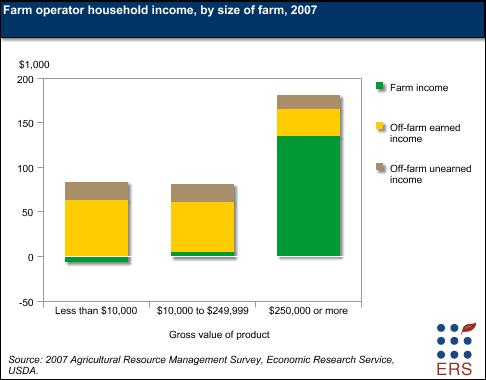 d
d
Commodity Specialization
A farm's specialization is determined by the one commodity
or group of commodities that makes up at least 50 percent
of the farm's total value of agricultural production
(see
glossary).
More farms are classified as beef cattle operations (30.6
percent) in 2007 than any other type of farm (see table).
Operators of beef farms consistently earn lower than average
household income than farms specializing in other commodities.
With little income from their farming enterprises, beef
farm households rely primarily on income from off-farm
sources. A large share of family farms (more than 40 percent)
do not have a single specialty and are classified as other
field crops or general livestock operations. Like beef
farms, they earn little or nothing from their farming
operations, in general, and rely on their off-farm sources
of income.
In contrast, dairy farm households rely heavily on the
farm for income, and they experienced a significant
increase in their farm income in 2007. As a result,
their total household incomes were above the U.S. average
for all farm households. Family farms specializing in
corn, soybeans, and other cash grain experienced increases
in farm household income in 2007 compared to 2006, while
hog and poultry producers experienced declines in their
household incomes.
Distribution of Farm Household
Incomes in 2007
An average household income estimate for all farm operator
households masks the great diversity in incomes. To illustrate
this diversity, many of the well-being indicators in this
briefing room are provided in a variety of classification
schemes. One way to illustrate diversity of incomes is
to chart the distribution of income, or the cumulative
share of households whose income is less than or equal
to a particular level. At the median, for example, 50
percent of households have less income and 50 percent
have more. For farm operator households, average income
exceeds median income because of the large share of high-income
households in the population. In 2007, average (mean)
income was $86,223, compared with a median of $52,455.
A cumulative distribution of 2007 household income by
residence farms, intermediate farms, and large farms illustrates
their different income performance. Households that operated
residence farms were the least likely to have negative
incomes and those that operated large farms were the most
likely to have negative incomes. The distributions of
income for residence and intermediate farm households
were relatively similar.
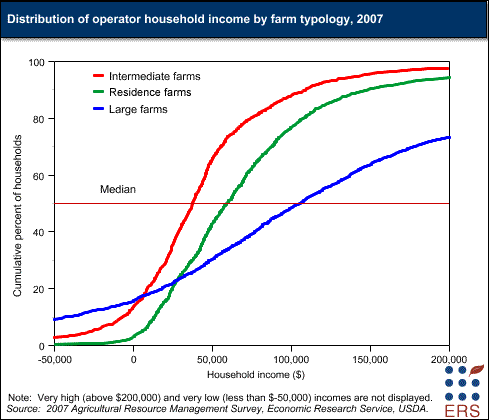
The median income of farm households in 2007 ($52,455)
was greater than the median for all U.S. households
($50,233), but less than that for just those U.S. households
that included self-employed persons. Nevertheless, farm
operator households are still more likely to have negative
household incomes than either self-employed or all U.S.
households.

Farm Operators' Household Income
Compared With U.S. Household Income
Since the 1980s, ERS has reported a money income measure
for farm operator households comparable to the U.S. Census
Bureau's measure for all U.S. households. Farm household
income is highly variable through the years, primarily
due to the volatility of farm income. Nonetheless, for
every year since 1996, average income of farm households
has exceeded average U.S. household income. In fact, the
off-farm income component (of average farm operator household
income) alone has exceeded average U.S. household income
from all sources since 1998.
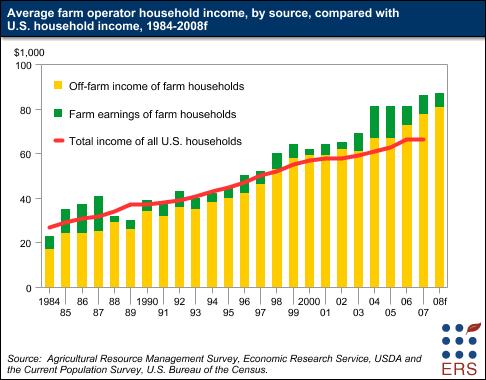 d d
A comparable income series is not available for earlier
years, but USDA developed another series that compared
the disposable personal
incomes of farm and nonfarm residents for 1934-1983.
This series (see figure)
shows that the current situation constitutes a reversal
of the historical situation; by the early 1970s, farm
resident income was 70 percent or more of nonfarm incomes.
Farm Operators' Household Income
for
15 Principal Farming States
Starting in 2003, the sample size of USDA's ARMS has
been large enough to allow for statistically reliable
estimates of farm and operator household income in 15
major agricultural States. Previous surveys did not provide
sufficient information to generate comparable estimates
by States.
Family farms in California realized the highest average
farm household income ($133,419) in 2007 (see table).
They also realized the highest average farm income,
at $52,357. High-value crop farms comprised more than
half of California family farms, and crop production
contributed about two-thirds of the State's total value
of production. Farm operator households in California
have average incomes above the average for all households
in the State. But California is not unusual in that
regard. Average income of farm operator households
exceeds the average income of all households in each
of the 15 States for which State-level estimates are
available. Because high incomes can have a strong impact
on averages of a population, we also compare the median
incomes of farm operator households to all households
in the State. The median income of farm operator households
in California was also higher than the median income
of all California households in 2007. For the other
States considered, median farm household income was
greater than that for the all household median income
in 2007, except for Georgia and Indiana.
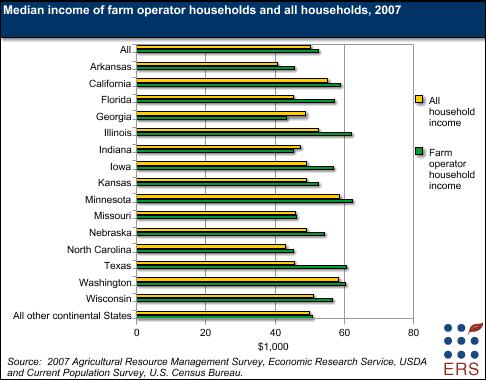 d
d
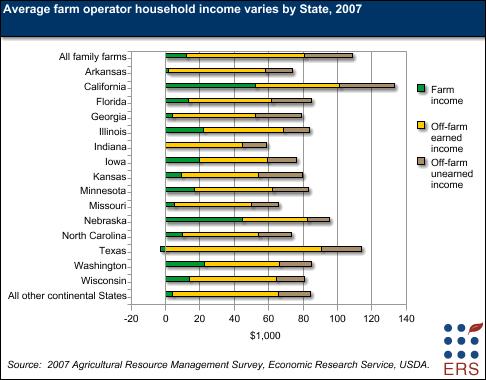 d
d
Composition of Operator Household
Income
In 2007, earnings from farming constituted an estimated
10 percent of the average income of farm operator households.
Two-thirds of income is considered earned off-farm income—most
is earned from off-farm wages and salary jobs and the
rest from nonfarm businesses (see table).
Retirement and other transfer income makes up about 12
percent of farm household income, with most coming from
public sources. Other important sources of income include
interest and dividend income.
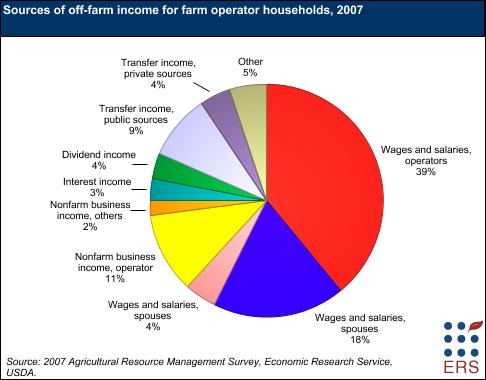 d
d
Many farm households that receive government payments
operate large farms, and so receive a higher share of
their household income from farming sources. Government
payments cannot easily be described as a share of farm
operator household income because payments and business
farm income are sometimes shared by multiple households—more
likely the case with larger farms—and because receipt
of payments often requires that farms incur costs. For
example, receipt of conservation payments often requires
farms to incur costs to adopt conserving practices.
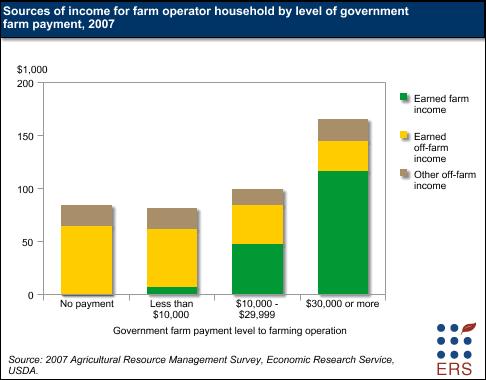 d
d
However, it is interesting to consider farm operator
household income sources by their level of government
payment. In 2007, 39.3 percent of family farms received
government payments, and most of those received less than
$10,000 in payments (see table).
Households operating farms that received no payments actually
averaged slightly higher household incomes than farms
that received farm payments under $10,000. However, the
farm operator households operating farms that received
$10,000 or more in farm payments had above-average household
incomes, as a result of their greater farm incomes. Most
farm payments are commodity-related rather than conservation
payments. Generally, the farms with the highest payments
also receive a higher share of their payments under commodity
programs than under conservation programs.
|



